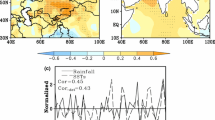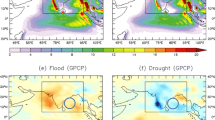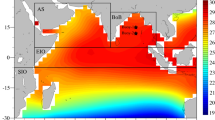Abstract
Monsoon droughts are characterized by the weakening of surface winds over the equatorial Indian Ocean and increased upper ocean heat storage, thus providing a sustained heat source for deep convection. This in turn increases rainfall over the eastern equatorial Indian Ocean and weakens the regional Hadley circulations, along with the subsidence of these circulations over the Indian subcontinent. To simulate reliable future climate projections, it is necessary to simulate the observed features during extreme monsoon events. In this study we examine the ability of climate models to simulate extreme rainfall events and their associated observed features over the Equatorial Indian Ocean (EIO) in the historical simulations of reliable IPCC CMIP5 models. Here we analyzed the Sea Surface temperature (SST), Ocean vertical temperature and rainfall anom alies during extreme rainfall events in the time period 1951–2005. In addition, we utilized reliable CMIP5 models which can simulate the Indian summer monsoon (ISM) and tried to study ocean features during extreme years. Drought years produce an abnormal su bsurf ace warming (0.5–1.5°C) over the Eastern Equatorial Indian Ocean (EEIO). This subsurface warming changes the wind pattern and causes drought in land regions of India. At the same time during excess monsoon years there is an abnormal cooling over the EEIO.
Similar content being viewed by others
References
Adler RF, Gu G, Wang JJ, Huffman GJ, Curtis S, Bolvin D (2008) Relationships between global precipitation and surface tempera ture on interannual and longer timescales (1979–2006). J Geophys Res 113:D22104. doi:https://doi.org/10.1029/2008JD010536
Annalisa C, Antonio N (2007) Sensitivity of the Asian summer monsoon to the horizontal resolution: Differences between AMIP-type and coupled model experiments. Clim Dynam 18: 273–290
Ashwini K (2012) Weakening of Indian summer monsoon rainfall in warming environment. Theor Appl Climatol 109: 447–459. doi:https://doi.org/10.1007/s00704-012-0591-4
Ashok K, Guan Z, Saji NH, Yamagata T (2004) Individual and combined influences of ENSO and the Indian Ocean Dipole on the Indian summer monsoon. J Climate 17: 3141–3155
Carton JA, Giese BS, Grodsky SA (2005) Sea level rise and the warming of the oceans in the SODA ocean reanalysis. J Geophys Res 110:C09006. doi:https://doi.org/10.1029/2004JC002817
Chang C, Harr P, Ju J (2001) Possible roles of Atlantic circulations on the weakening Indian Monsoon Rainfall-ENSO relationship. J Climate 14: 2376–2380
Crétat J, Terray P, Masson S, Sooraj KP, Roxy MK (2017) Indian Ocean and Indian summer monsoon: relationships without ENSO in ocean–atmosphere coupled simulations. Clim Dynam 49: 1429–1448. doi:https://doi.org/10.1007/s00382-016-3387-x
Johny A, Ramesh KV (2019) Developing reliable climate projections for the continental monsoon regions. J Clim Chang 5(2):51–71. doi:https://doi.org/10.3233/JCC190012
Kalnay E, Kanamitsu M, Kistler R, Collins W, Deaven D, Gandin L, Iredell L, Saha S, White G, Woollen J, Zhu Y, Chelliah M (1996) The NCEP/NCAR 40-year reanalysis project. B Am Meteorol Soc 77: 437–470
Kumar K, Rajagopalan B, Cane MA (1999) On the weakening relationship between the Indian Monsoon and ENSO. Science 284: 2156–2159. doi:https://doi.org/10.1126/science.284.5423.2156
Kumar K, Rajagopalan B, Hoerling M, Bates G, Cane MA (2006) Unraveling the mystery of monsoon failure during El Niño. Science 314: 115–119 doi:https://doi.org/10.1126/science.1131152
Krishnan R, Ramesh KV, Samala BK, Meyers G, Slingo JM, Fennessy MJ (2006) Indian Ocean-monsoon coupled interactions and impending monsoon droughts. Geophys Res Lett 33:L08711. doi:https://doi.org/10.1029/2006GL025811
Lau K, Wu HT (2001) Principal modes of rainfall–SST variability of the Asian Summer Monsoon: A reassessment of the Monsoon-ENSO relationship. J Climate 14: 2880–2895
Liu X, Yanai M (2001) Relationship between the Indian monsoon rainfall and the tropospheric temperature over the Eurasian continent. Q J Roy Meteor Soc 127: 909–937. doi:https://doi.org/10.1002/qj.49712757311
Li G, Xie S, Du Y (2015a) Monsoon-induced biases of climate models over the Tropical Indian Ocean. J Climate 28: 3058–3072. doi:https://doi.org/10.1175/JCLI-D-14-00740.1
Li G, Xie S, Du Y (2015b) Climate model errors over the South Indian Ocean thermocline dome and their effect on the basin mode of interannual variability. J Climate 28: 3093–3098. doi:https://doi.org/10.1175/JCLI-D-14-00810.1
Li G, Xie S, Du Y (2016) A robust but spurious pattern of climate change in model projections over the Tropical Indian Ocean. J Climate 29: 5589–5608. doi:https://doi.org/10.1175/JCLI-D-15-0565.1
Li G, Xie S-P, He C, Chen Z (2017) Western Pacific emergent constraint lowers projected increase in Indian summer monsoon rainfall. Nat Clim Change 7: 708–712. doi:https://doi.org/10.1038/nclimate3387
Naidu CV, Muni Krishna K, Rao SR, Bhanu Kumar OSRU, Durgalakshmi K, Ramakrishna SSVS (2011) Variations of Indian summer monsoon rainfall induce the weakening of easterly jet stream in the warming environment? Global Planet Change 75(1–2):21–30. doi:https://doi.org/10.1016/j.gloplacha.2010.10.001
Goswami P, Ramesh KV (2008) The expanding Indian Desert: a weighted epochal trend ensemble analysis. Curr Sci India 94: 476–480
Rajeevan M, Pai DS, Thapliyal V (2002) Predictive relationships between Indian Ocean sea surface temperatures and Indian summer monsoon rainfall. Mausam 53: 337–348
Ramanathan V, Chung C, Kim D, Bettge T, Buja L, Kiehl JT, Washington WM, Fu Q, Sikka DR, Wild M (2005) Atmospheric brown clouds: Impacts on South Asian climate and hydrological cycle. P Natl Acad Sci USA 102(15):5326–5333. doi:https://doi.org/10.1073/pnas.0500656102
Ramesh KV, Goswami P (2007) Reduction in spatial and temporal extent of Monsoon rainfall. Geophys Res Lett 34:L23704. doi:https://doi.org/10.1029/2007GL031613
Ramesh KV, Goswami P (2014) Assessing reliability of regional climate projections: The case of Indian monsoon. Sci Rep-UK 4:4071. doi:https://doi.org/10.1038/srep04071
Rao K G, Goswami BN (1988) Interannual variations of sea surface temperature over the Arabian Sea and the Indian monsoon: a new perspective. Mon Weather Rev 116: 558–568
Rasmussen EM, Carpenter TH (1983) The relationship between eastern equatorial Pacific SSTs and rainfall over India and Sri Lanka. Mon Weather Rev 111: 517–528
Saji NH, Goswami BN, Vinayachandran PN, Yamagata T (1999) A dipole mode in the tropical Indian Ocean. Nature 401: 360–363. doi:https://doi.org/10.1038/43854
Sikka DR (1980) Some aspects of the large scale fluctuations of summer monsoon rainfall over India in relation to fluctuations in the planetary and regional scale circulation parameters. P Indian AS-Earth 89: 179–195. doi:10.1007/BF02913749
Slingo JM, Annamalai H (2000) 1997: The El Niño of the century and the response of the Indian summer monsoon. Mon Weather Rev 128: 1778–1797
Syroka J, Toumi R (2004) On the withdrawal of the Indian summer monsoon. Q J Roy Meteor Soc 130: 989–1008. doi:10.1256/ qj.03.36
Taylor KE, Stouffer RJ, Meehl GA (2012) An overview of CMIP5 and the experiment design. B Am Meteorol Soc 93: 485–498. doi:https://doi.org/10.1175/BAMS-D-11-00094.1
Webster PJ, Moore AW, Loschnigg JP, Leben RR (1999) Coupled ocean-atmosphere dynamics in the Indian Ocean during 1997–1998. Nature 401: 356–360. doi:https://doi.org/10.1038/43848
Webster PJ, Magana VO, Palmer TN, Shukla J, Tomas RA, Yanai M, Yasunari T (1998) Monsoons: Processes, predictability, and the prospects for prediction. J Geophys Res 103(14):14451–14510. doi:https://doi.org/10.1029/97JC02719
Wentz FJ, Ricciardulli L, Hilburn K, Mears C (2007) How much more rain will global warming bring? Science 317(5835):233–235. doi:https://doi.org/10.1126/science.1140746
Yadav RK (2009a) Role of equatorial central Pacific and northwest of North Atlantic 2-metre surface temperatures in modulating Indian summer monsoon variability. Clim Dynam 32: 549–563. doi:https://doi.org/10.1007/s00382-008-0410-x
Yadav RK (2009b) Changes in the large-scale features associated with the Indian summer monsoon in the recent decades. Int J Climatol 29: 117–133. doi:https://doi.org/10.1002/joc.1698
References (Appendix)
Furevik T, Bentsen M, Drange H, Kindem IKT, Kvamstø NG, Sorteberg A (2003) Description and validation of the Bergen Climate Model: ARPEGE coupled with MICOM, Clim Dynam 21: 27–51
Gent PR, Danabasoglu G, Donner LJ, Holland MM, Hunke EC, Jayne SR, Lawrence DM, Neale RB, Rasch PJ, Vertenstein M, Worley PH, Yang Z-L, Zhang M (2011) The Community Climate System Model Version 4. J Climate 24:4973–4991. doi:https://doi.org/10.1175/2011JCLI4083.1
Ilyina T, Six KD, Segschneider J, Maier-Reimer E, Li H, Núñez-Riboni I (2013) Global ocean biogeochemistry model HAMOCC: Model architecture and performance as component of the MPI-Earth system model in different CMIP5 experimental realizations. J Adv Model Earth Sy 5: 287–315. doi:https://doi.org/10.1029/2012MS000178
Jungclaus JH, Fischer N, Haak H, Lohmann K, Marotzke J, Matei D, Mikolajewicz U, Notz D, von Storch JS (2013) Characteristics of the ocean simulations in MPIOM, the ocean component of the MPI-Earth system model. J Adv Model Earth Sy 5: 422–446. doi:https://doi.org/10.1002/jame.20023
Reick CH, Raddatz T, Brovkin V, Gayler V (2013) Representation of natural and anthropogenic land cover change in MPI-ESM. J Adv Model Earth Sy 5: 459–482. doi:https://doi.org/10.1002/jame.20022
Rotstayn LD, Collier MA, Dix MR, Feng Y, Gordon HB, O’Farrell SP, Smith IN, Syktus J (2010) Improved simulation of Australian climate and ENSO-related rainfall variability in a global climate model with an interactive aerosol treatment. Int J Climatol 30: 1067–1088. doi:https://doi.org/10.1002/joc.1952
Schneck R, Reick CH, Raddatz T (2013) Land contribution to natural CO2 variability on time scales of centuries. J Adv Model Earth Sy 5: 354–365. doi:https://doi.org/10.1002/jame.20029
Stevens B, Giorgetta M, Esch M, Mauritsen T, Crueger T, Rast S, Salzmann M, Schmidt H, Bader J, Block K, Brokopf R, Fast I, Kinne S, Kornblueh L, Lohmann U, Pincus R, Reichler T, Roeckner (2013) Atmospheric component of the MPI-M Earth System Model: ECHAM6. J Adv Model Earth Sy 5: 146–172. doi: https://doi.org/10.1002/jame.20015
Acknowledgements
Authors are thankful for the World Climate Research Programme and the modeling groups for making available the CMIP model outputs. The authors are thankful to DST, SERB, GoI for funding the project “Extreme Weather and Climate Events in the 21st Century Projections from Different Climate Scenario”: SERB/F/4545/2013- 2014.
Author information
Authors and Affiliations
Corresponding author
Additional information
Publisher’s Note Springer Nature remains neutral with regard to jurisdictional claims in published maps and institutional affiliations.
Rights and permissions
About this article
Cite this article
Johny, A., Ramesh, K.V. Equatorial Indian Ocean Response during Extreme Indian Summer Monsoon Years Using Reliable CMIP5 Models. Ocean Sci. J. 55, 17–31 (2020). https://doi.org/10.1007/s12601-020-0006-x
Received:
Revised:
Accepted:
Published:
Issue Date:
DOI: https://doi.org/10.1007/s12601-020-0006-x




